Dukedoms in Portugal
The highest hereditary title in the Portuguese monarchy. By tradition, there are a total of five royal and seven non-royal dukes in Portugal, out of 28 dukedoms that have ever been created. In the majority of cases, the title of duke was attributed to members of the high nobility, usually relatives of the Portuguese Royal Family, such as the second son of a monarch.
| |
| |
| |
| |
| |
There are exceptions, like António José de Ávila, who, although not having any relation to the royal family, was given the title of duke of Ávila and Bolama.
Royal dukedoms
Hereditary royal dukedoms
- Duke of Braganza (the principal grandeza of the Portuguese royal dynasty. After the restoration of a Portuguese dynasty in 1640, it became a title of the heir apparent to the crown, and passes to his heir, when he becomes king.)
Courtesy royal dukedoms
These titles were occasionally given to other infantes of the Royal Family, but did not automatically descend to their heirs:
Noble dukedoms
All of these dukedoms are inherited, but only some of them are titles de juro e herdade – this meant that the reigning monarch was obliged to renew the title for its rightful heir whenever a titleholder died. Only Aveiro, Lafões, Terceira, Palmela, Saldanha and Loulé were dukedoms de juro e herdade. Some of these dukes (Cadaval, Terceira and Saldanha) enjoyed Honras de Parente, i.e. certain honours (of style and/or precedence) associated with being an officially recognised relative of the king.
- Before the Liberal Regime:
- Duke of Aveiro and Duke of Torres Novas (both extinct in 1759, after the execution of the last duke for high treason). The first duke was the elder son of the 2nd Duke of Coimbra, the sole surviving (but illegitimate) son of King John II of Portugal;
- Duke of Cadaval, family Álvares Pereira de Mello, branch of the House of Braganza before they were kings;
- Duke of Caminha and Duke of Vila Real (both extinguished following executions for high treason of their titleholders for supporting the right of the Spanish Habsburg kings to the Portuguese throne after the revolution of 1640;
- Duke of Lafões, families Bragança, Sousa and Menezes. The first duke was an illegitimate son of King Pedro II of Portugal. Also Count of Miranda do Corvo and Marquis of Arronches (Sousa) and Count of Cantanhede and Marquis of Marialva (Menezes) and also Duke of Miranda do Corvo (Bragança);
- Duke da Vitória (this victory title, meaning in Portuguese "Duke of the Victory", was given to Arthur Wellesley, Duke of Wellington. This is the only Portuguese dukedom granted to a foreigner and whose titleholders remained foreign citizens living outside of Portugal).
- After the Liberal Regime:
- Duke of Terceira, 1832, Descendants of Ferdinand III of Castile, by his son, Infante Manuel of Castile. Heads of the Portuguese branch of the Manoel de Vilhena family, since the marriage of Constance Manoel with King Pedro I of Portugal. Her brother, Henrique Manoel, was brought in her entourage, and made Count of Seia, in Portugal by his brother-in-law. Following the long line of military tradition of his family, António José de Sousa Manoel de Meneses Severim de Noronha, 1st Duke of Terceira, Marquis and 7th Count of Vila Flor, was Marshal of the Army and President of the Council of Ministers.
- Duke of Palmela, 1833, formerly Duke of Faial, replaced by the title of Duke of Palmela (family Sousa e Holstein), descending in the female line from the Dukes of Holstein. Also 1st Marquis of Faial, 1st Marquis of Palmela, 1st Count of Palmela and 1st Count of Calhariz. The first duke was President of the Council of Ministers and a quite remarkable ambassador in London and to the Congress of Vienna;
- Duke of Saldanha, 1857, family Saldanha Oliveira e Daun. Also 1st Marquis of Saldanha, 1st Count of Saldanha and 1st Count of Almoster. The first duke was President of the Council of Ministers and Marshal of the Army;
- Duke of Loulé, 1862, family Mendonça, also 8th Count of Vale de Reis and 2nd Marquis of Loulé, descending from Infanta Ana de Jesus Maria of Portugal. The first duke was President of the Council of Ministers;
- Duke of Ávila and Bolama, 1878, family Ávila. First dukedom granted to a commoner. The first duke was President of the Council of Ministers;
- Duke of Albuquerque, 1886, family Costa de Sousa de Macedo, also 2nd Count of Mesquitela, 5th Viscount of Mesquitela and formerly Baron of Mullingar, in Ireland.
Non-hereditary dukedoms
These titles were traditionally granted to the Lady Chamberlain (Camareira-Mor), the highest royal court office for a woman, only during her life:
- Duchess of Abrantes, granted to two Marchionesses of Abrantes.
- Duchess of Ficalho, to one Marchioness of Ficalho.
- Duchess of Linhares, to one Countess of Linhares.
- Duchess of Tancos, to one Marchioness of Tancos.
List
| Coat of Arms | Title | Date of creation | Surname | First titular |
|---|---|---|---|---|
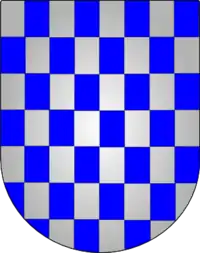 | Duke of Abrantes | December 9, 1753 | Lorena | Ana Maria Catarina Henriqueta de Lorena |
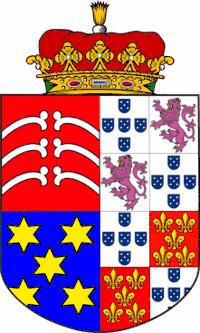 | Duke of Albuquerque | May 19, 1886 | Costa de Sousa de Macedo | João Afonso da Costa de Sousa de Macedo |
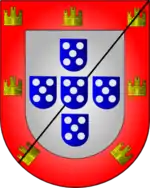 | Duke of Aveiro | b. 1535 | Lencastre Mascarenhas da Silva e Lencastre | John of Lencastre, 1st Marquis of Torres Novas |
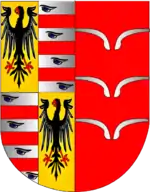 | Duke of Ávila and Bolama | May 14, 1878 | Ávila | António José de Ávila |
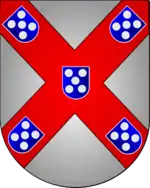 | Duke of Barcelos | August 5, 1562 | Bragança | John, 6th Duke of Braganza |
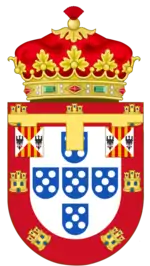 | Duke of Beja | 1453 | Portugal-Aviz Bragança | Ferdinand, Duke of Viseu |
 | Duke of Braganza | 1442 | Bragança | Afonso, Count of Barcelos |
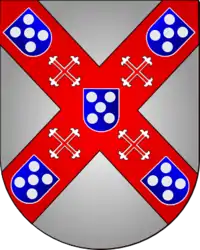 | Duke of Cadaval | April 26, 1648 | Álvares Pereira de Melo | Nuno Álvares Pereira de Melo |
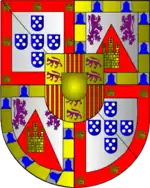 | Duke of Caminha | December 14, 1620 | Menezes | Miguel Luís de Menezes |
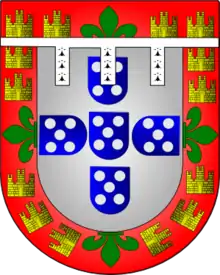 | Duke of Coimbra | 1415 | Portugal-Aviz Lencastre Bragança | Pedro, Prince of Portugal |
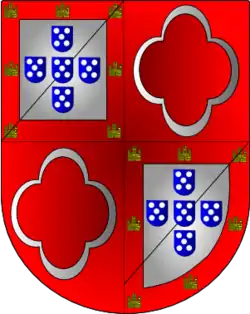 | Duke of Faial | April 4, 1833 | Sousa Holstein | Pedro de Sousa Holstein |
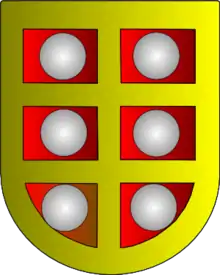 | Duke of Ficalho | May 14, 1836 | Almeida | Eugénia Maurícia Tomásia de Almeida Portugal |
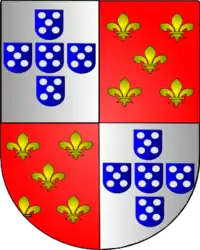 | Duke of Goa | 1515 | Albuquerque | Afonso de Albuquerque |
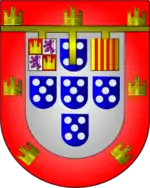 | Duke of Guarda | October 5, 1530 | Portugal-Aviz | Ferdinand, Prince of Portugal |
 | Duke of Guimarães | 1475 | Bragança | Fernando II, Duke of Braganza |
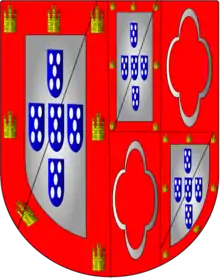 | Duke of Lafões | February 17, 1718 | Bragança Bragança e Ligne de Sousa Tavares Mascarenhas da Silva | Pedro Henrique de Bragança |
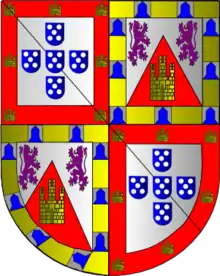 | Duke of Linhares | ? | Noronha | Fernando de Noronha |
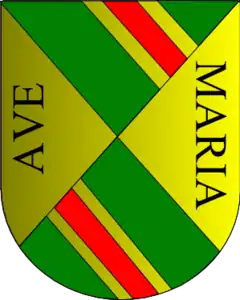 | Duke of Loulé | October 3, 1852 | Mendonça Rolim de Moura Barreto | Nuno José Severo de Mendonça Rolim de Moura Barreto |
 | Duke of Miranda do Corvo | May 13, 1796 | Bragança e Ligne de Sousa Tavares Mascarenhas da Silva | José Sousa Tavares Mascaranhas da Silva |
 | Duke of Palmela | October 10, 1850 | Sousa Holstein | Pedro de Sousa Holstein |
 | Duke of Porto | 1833 | Bragança | Maria, Princess of Portugal (future Queen Maria II) |
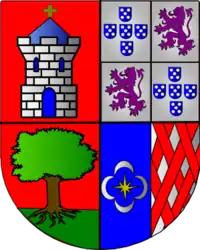 | Duke of Saldanha | November 4, 1846 | Saldanha Oliveira e Daun | João Francisco de Saldanha Oliveira e Daun |
 | Duke of Tancos | April 22, 1790 | Manoel | Constança Manoel |
 | Duke of Terceira | November 8, 1832 | Manoel e Meneses Severim de Noronha | António José de Sousa Manoel e Meneses Severim de Noronha |
 | Duke of Torres Novas | September 26, 1619 | Lencastre | George of Lencastre |
 | Duke of Trancoso | 1530 | Portugal-Aviz | Ferdinand, Prince of Portugal |
 | Duke of Vila Real | February 28, 1585 | Menezes | Manuel de Menezes |
 | Duke of Viseu | 1415 | Portugal-Aviz | Henry, the Navigator, Prince of Portugal |
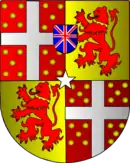 | Duke of Vitória | December 12, 1812 | Wellesley | Arthur Wellesley, Duke of Wellington |
See also
- Portuguese nobility
- List of marquesses in Portugal
- List of countships in Portugal
- List of viscountcies in Portugal
- List of barons in Portugal
.svg.png.webp)